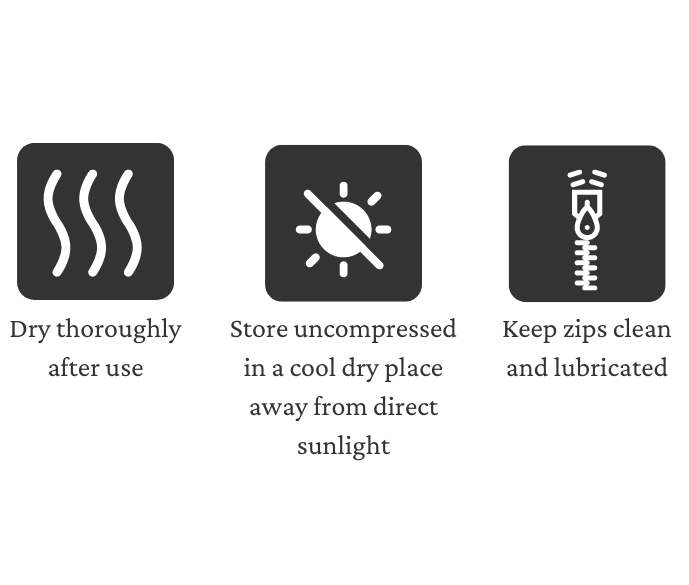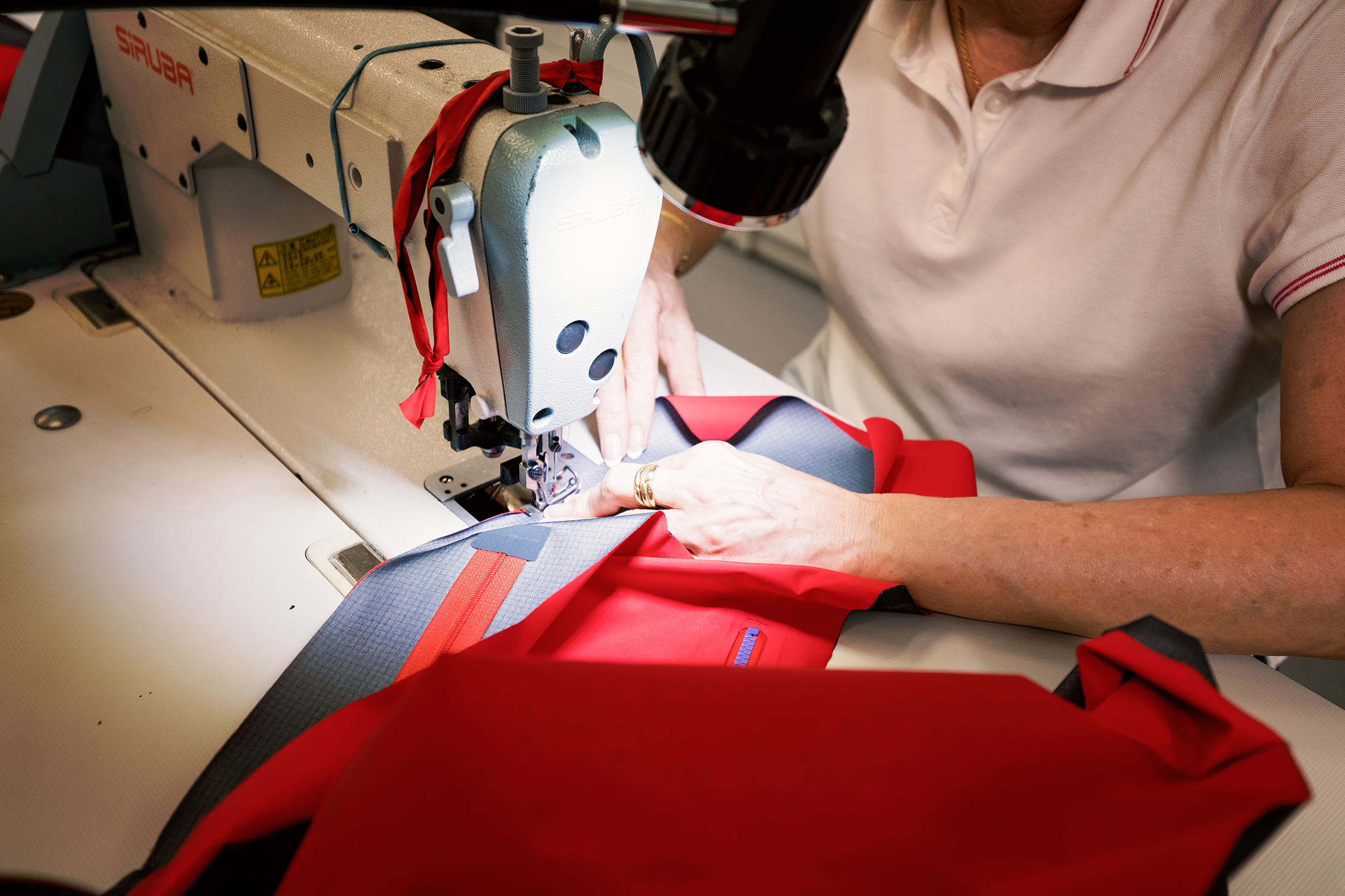General Care
A synthetic bag should provide years of service but as with any sleeping bag it will last longer and perform better if cared for correctly. During use, especially on extended trips, air your sleeping bag whenever practical and dry thoroughly before storing.
When not in use, store your sleeping bag in a cool dry place away from direct sunlight; store uncompressed, loose in a large box or pillow case. If possible avoid storing inside its stuff-sack for long periods of time. Small stains and spillages can usually be cleaned with a damp soapy cloth but avoid washing your bag unless it really needs it. Zips should be kept clean and regularly lubed.

How to Wash Your Synthetic Sleeping Bag
Synthetic sleeping bags are easier to care for than down filled ones especially when it comes to washing and drying, but even so they should be washed only when absolutely necessary.
The sleeping bag should ideally be washed using a specialist cleaning product such as Grangers Performance Wash, Nikwax Tech Wash, Fibertec Pro Wash, or Storm Clothing Wash. If these aren’t available then soap flakes which can be purchased from a supermarket are also fine, and failing that simple liquid detergent without fabric softeners can be used but is not something we officially recommend.
Before you begin, clean any detergent out of your washing machine: if you use the powder drawer, give it a thorough clean, pouring hot water down it to remove any residue. Finally, run a short rinse cycle with the machine empty to clear any remaining detergent.
Ensure all drawcords under tension are released and velcro tabs fastened. The side zip should be undone fully and the zip head disengaged.
Read the care label. Select the appropriate wash cycle on your machine - ideally this should be a programme with a low to medium spin speed setting such as Delicates, Woollens or Handwash and with a temperature setting of 30°C. Rinse extremely thoroughly (at least twice).
When removing your sleeping bag from the machine, do so carefully - especially for heavily insulated sleeping bags as the extra weight of any wet filling could damage internal stitching.
Most lightweight synthetic sleeping bags are easily air dried but for heavier weight bags we recommend the use of a tumble dryer. This should be done slowly, using a tumble dryer set to the lowest heat setting available. Selecting a higher temperature in the hope of drying more quickly could easily damage the fabrics and components of your bag.
Once thoroughly dried, all components such as cordlocks should be checked and zips thoroughly lubed. We recommend using a product such as Gear Aid Zipper Lubricant, McNETT Zip Care or Zipper Stick. Alternatively natural products such as Beeswax can also be used.
Field Repairs
Sleeping bags are by their very nature lightweight and as such the demands of climbing and mountaineering can cause damage usually in the form of snags, tears and burns to even the most well designed product. Such damage is not covered by our warranty as this is deemed normal, if unfortunate, wear and tear. However, many of these faults can be repaired both ‘in the field’ and professionally.
-
Small Tears - Gaffa Tape / Duct Tape
Gaffa Tape or Duct tape applied over the immediate tear can work effectively for short-term fixes. The outer fabric needs to be clean and dry. Any filling should be compressed flat before application. It’s unlikely to be a permanent solution.
-
Small to Medium Sized Tears etc - Tenacious Tape™ or Betrafol® Tape
Specialist repair tapes such as Tenacious Tape™ or Betrafol® Tape can be very effective at repairing small tears, but they do have a somewhat distinctive aesthetic. Please be aware however that such tapes, whilst extremely durable and often able to endure sustained use even at very low temperatures can leave residual marks which when taken off are near impossible to remove.
-
Jammed or stiff Zip Pulls
Prevention is the best form of cure so regularly clean all zips using warm, soapy water. Do not force jammed zips. If washing and lubing a zip does not free a zip, carefully inspect the zip head for obvious signs of grit or dirt. If tooth or coil damage is visible then the zip puller has already had too much force exerted on it. Only a professional repair can solve this.
Professional Repairs
Should you require a professional repair, many of the common problems which occur through use can be rectified and will ensure your sleeping bag continues to provide many more years of service. This includes partially or completely replacing zips, replacing or re-attaching drawcords, professionally patching fabric tears or nicks and repairing damaged seams. Contact us for further information.

End of Life
Whilst a synthetic sleeping bag should last many years, most synthetic fillings degrade over time - losing loft and warmth no matter how well they have been cared for. If you think your bag is nearing the end of its life please do everything you can to prolong it. Use it until it falls apart. Manufacturing synthetic sleeping bags which can be complex and involve many components and materials is very energy intensive and one of the most effective ways of reducing their environmental impact is, as strange as it may seem for us to say, to make what you buy last as long as possible and not replace it needlessly.
Here’s what you should do instead:
1) Revere it: Our products are made to be used. Learn to value the experience etched into the very fabric of your gear. Every nick, every mark is not just wear & tear but a story and a statement.
2) Revitalise it - Wash and maintain your bag when required and store appropriately. You can do this yourself or use the services of a professional aftercare service.
3) Repair it - Many minor faults that may seem terminal can actually be easily fixed. It may seem expensive but think about the cost not just of a new sleeping bag but the bigger environmental cost to your consumption.
4) Relegate it - Just because your sleeping bag is no longer warm enough for a trip to Baffin Island does not mean that it isn't ‘good enough’ for a wide range of less severe uses. So consider relegating your bag to one used for summer camping trips or valley use.
5) Reappropriate it - Use the bag for something it was not originally designed for but works perfectly for. Keep an old sleeping bag in your car in case of breakdowns or that handy overnight bag for impromptu stay-overs with friends.
6) Reassign it - Just because a sleeping bag may not meet your needs any longer it may meet someone elses. Don’t use this as an excuse to not think about your own actions (!) - but there are numerous specialist charities who need outdoor gear and many groups, including homeless charities will gratefully receive donations of used sleeping bags, even if slightly damaged, provided they are clean.
7) Reuse it - Unlike down sleeping bags, synthetic bags are much easier to re-use. They can be cut up and re-sewn into dog blankets, or be used as padding for packing bulky or delicate items in transit or even used to insulate something other than you!
8) Recycle it - Recycling can save energy and resources that would otherwise be used in the manufacture of virgin materials. But many synthetic bags remain difficult to recycle effectively despite the fact that some of the materials found within the bag can be and are found in low-grade non-woven insulation for ducting etc.. That’s why we’d ask that you try to do everything you can to keep your sleeping bag in use for longer.









